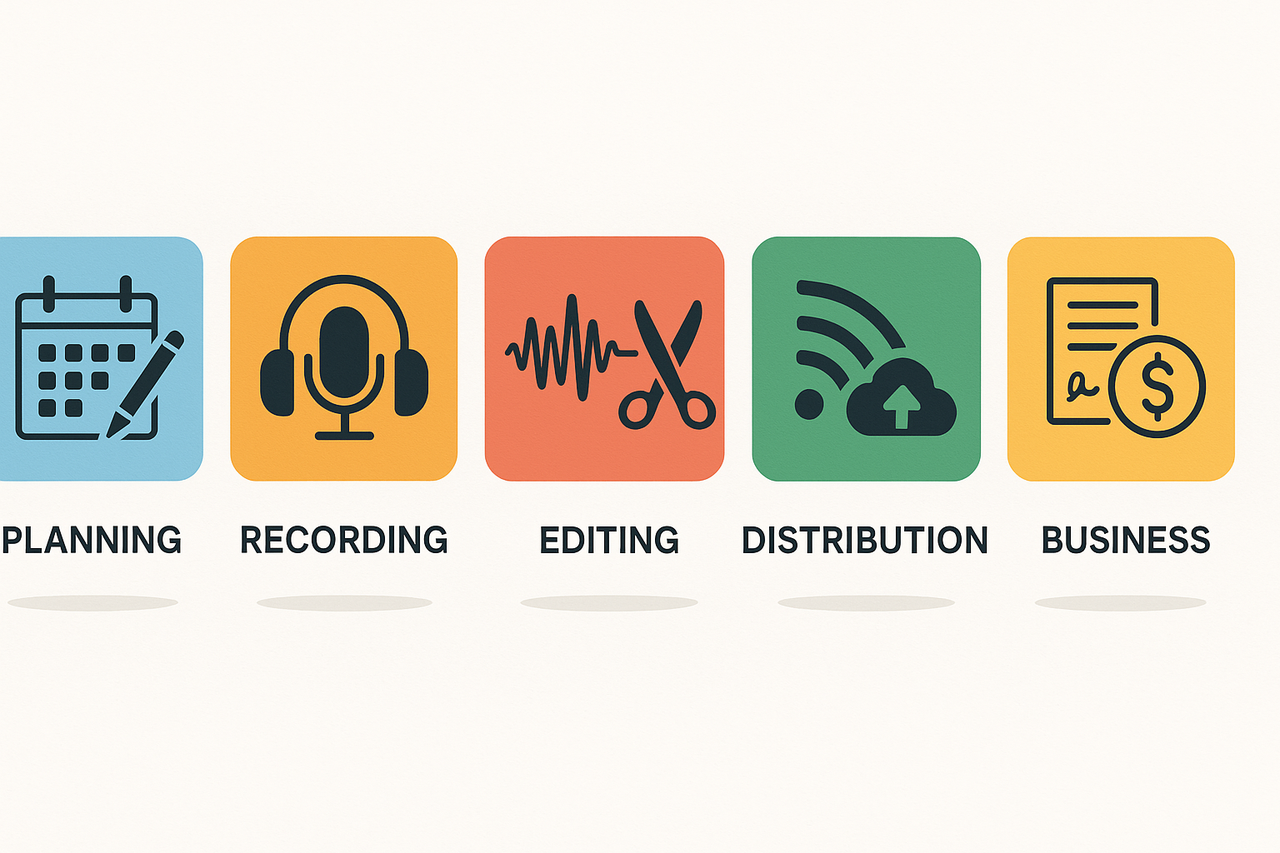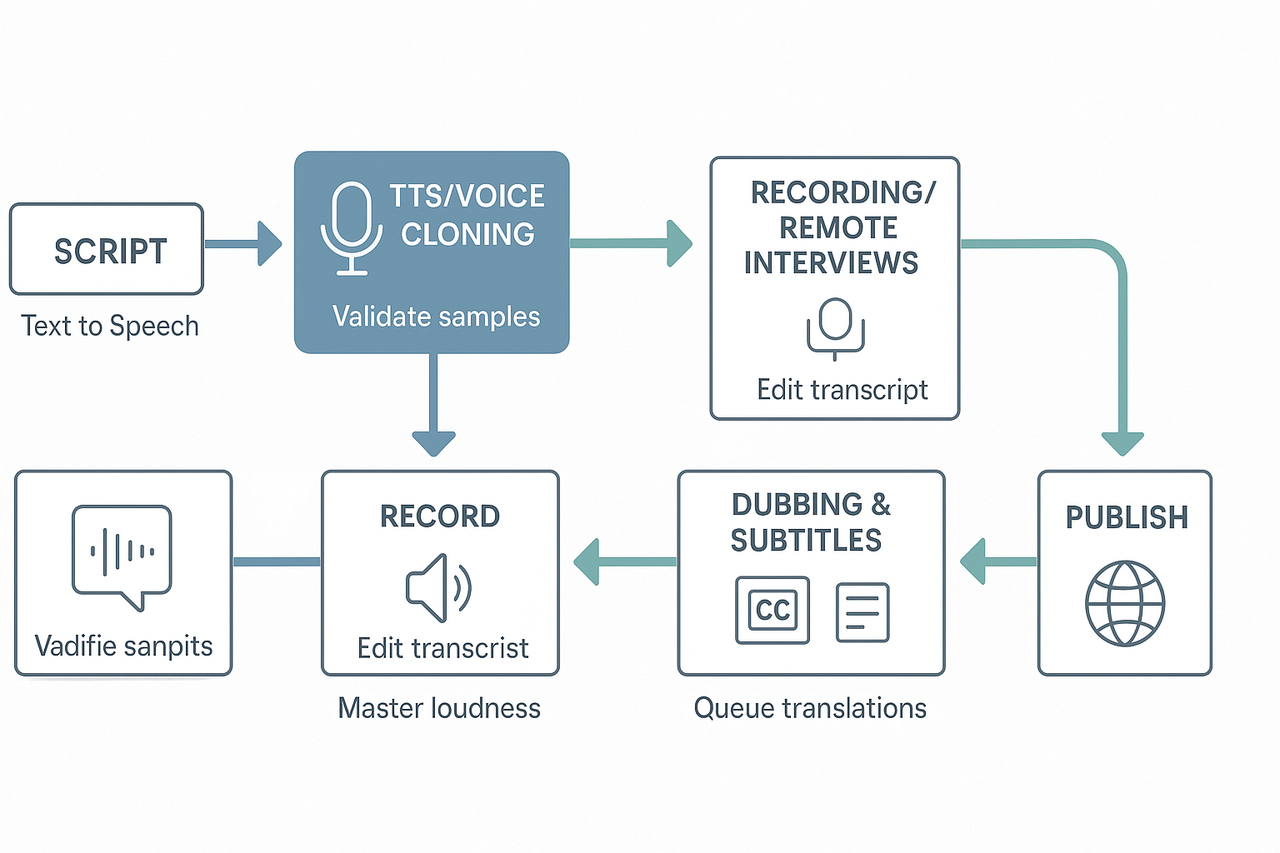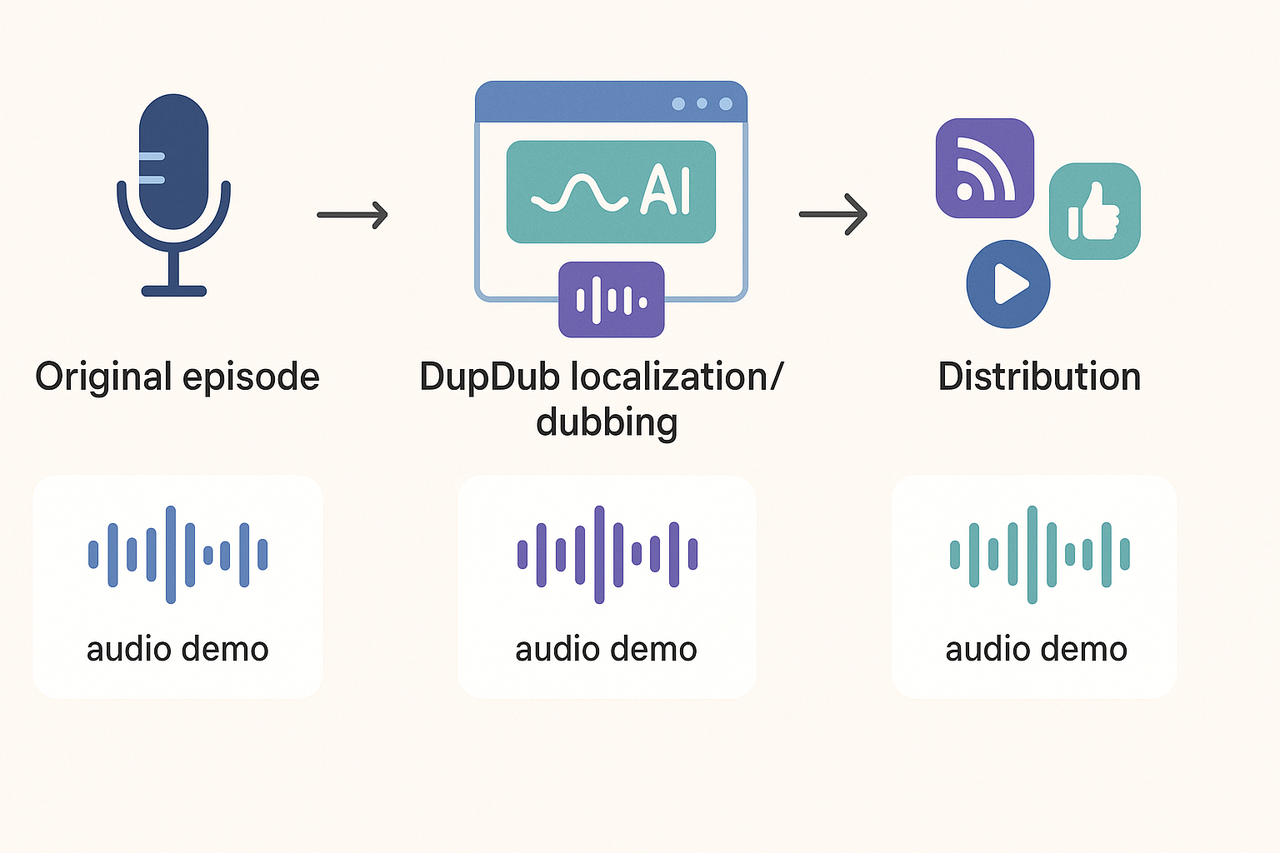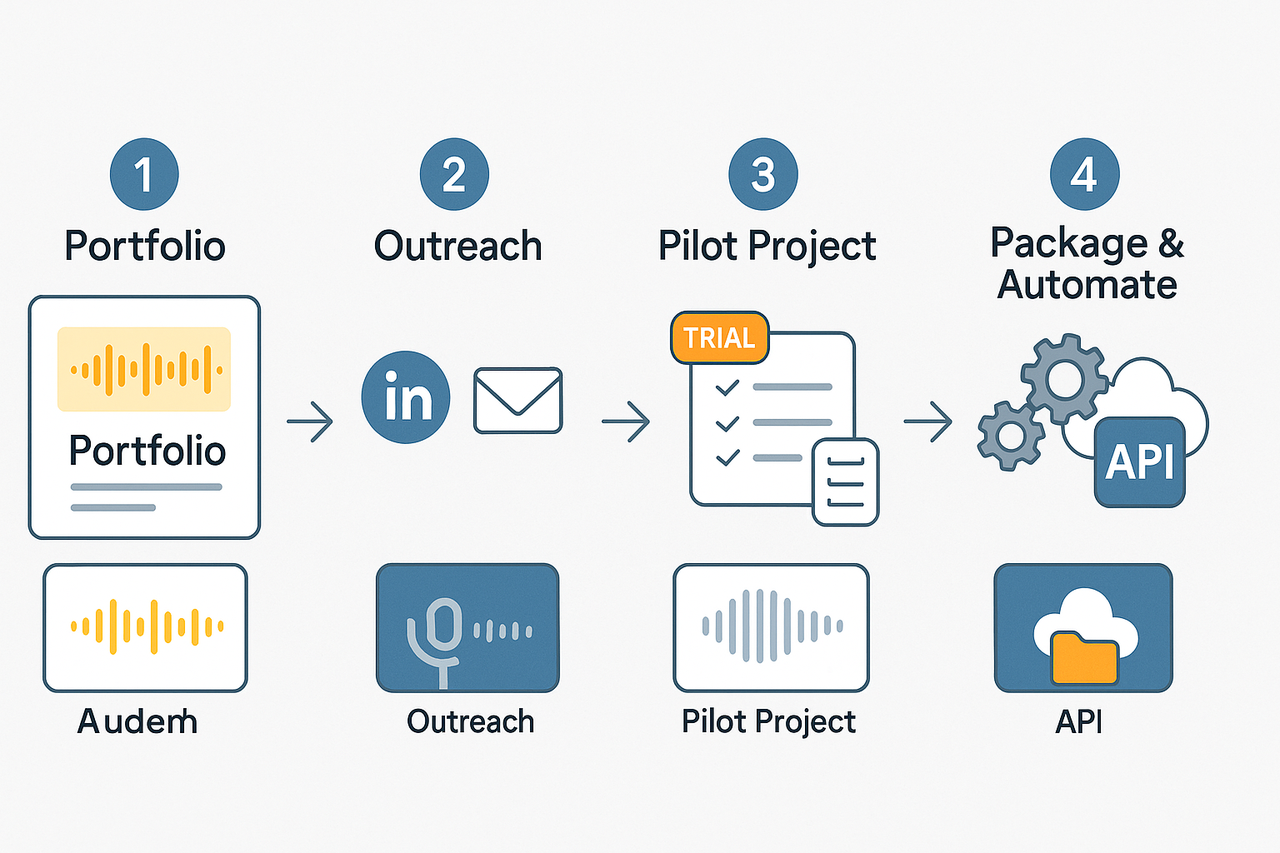TL;DR: Can you become a podcast producer using AI voices? Quick answer and who this guide is for
Yes, you can become a podcast producer today using AI voices. It takes production skills, editing chops, and strong ethical habits. If you’re asking how to become a podcast producer, this guide maps core skills and the workflows you’ll need. It also shows practical business steps.
This guide is for aspiring producers, freelance audio pros, marketers, and small in-house teams. If you edit audio, manage talent, or scale content, you’ll get the most value. Basic DAW (digital audio workstation) skills help, but they’re not required to start.
Expect hands-on workflows, short experiments with AI voices, and legal checklists. You’ll learn how to test tools, measure voice quality, and build repeatable templates. Follow the step-by-step sections to try concepts fast and pick your next learning path.
What a podcast producer actually does in 2025 (skills, day-in-the-life, salary ranges)
If you want to learn how to become a podcast producer, this section maps the modern role and pay benchmarks for 2025. Producers now own every stage, from planning and talent coaching to final delivery and analytics. Read on for core tasks, a typical day, must-have skills, and realistic pay ranges.
Core responsibilities and outcomes
-
Episode planning and research: outlines, guest prep, show notes, and segment scripting.
-
Recording and remote session management: mic setup, routing, clean takes, and recording notes.
-
Editing and mix: noise removal, leveling, cadence edits, music beds, and mastering for platforms.
-
Postproduction and localization: TTS or voice cloning drafts, transcriptions, subtitles, and translations.
-
Distribution and analytics: RSS management, metadata, monetization, and listener metrics.
-
Client and business ops: invoicing, contracts, rights management, and workflow automation.
A typical day: indie freelancer vs in-house team
Indie freelancer
-
Mornings: client calls, episode planning, and booking guests.
-
Midday: record interviews, fix audio problems, do first-pass edits.
-
Afternoons: finalize mix, export files, send deliverables, then prospecting.
In-house producer
-
Start with standups and editorial syncs.
-
Run studio sessions or remote feeds and manage editors.
-
End with distribution checks, cross-team handoffs, and performance reviews.
Both paths need fast context switching and tool fluency.
Skills recruiters expect in 2025
-
Strong audio editing and mixing skills, with DAW fluency (explain DAW: digital audio workstation).
-
Remote session tools, TTS and AI voice workflows, and subtitle pipelines.
-
Solid metadata, SEO for episodes, and platform delivery standards.
-
Communication, project management, and basic scripting or content writing.
Salary and freelance rate benchmarks
Approximate ranges you can expect:
Use these bands to set targets and price your services by skill, output, and turnaround time.
Why synthetic voices and AI podcast generators are changing the job: risks and opportunities
AI audio tools change what a producer can do each week. If you’re learning how to become a podcast producer, know this: text-to-speech (TTS, automated voice generation) and AI podcast generators shrink turnaround, expand localization, and let small teams publish at scale. This section explains the upside, the legal red flags, and simple rules to decide when to use real talent.
Scale, speed, and new capabilities
AI makes routine tasks fast and repeatable. You can turn scripts into finished audio in minutes, localize episodes into many languages, and produce multiple ad versions automatically. That means more shows per month and tighter deadlines.
Key opportunities:
-
Faster production: cut editing and re-record time by 50% or more.
-
Multilingual reach: one episode, many languages, consistent timing and subtitles.
-
Iteration at scale: test intros, ad reads, and episode variations quickly.
-
Cost efficiency: lower per-episode labor for routine narration.
Platforms that unify TTS, voice cloning, transcription, and video workflows streamline these gains; DupDub is one example of a unified platform that speeds end-to-end tasks.
Risks, disclosure, and legal issues
Synthetic audio creates clear risks around voice rights and deception. Use care when cloning a real person or imitating public figures. The
FTC's Endorsement Guides, updated in June 2023, emphasize that advertisers must disclose material connections between endorsers and marketers to prevent deceptive practices. Also watch privacy rules: many countries treat voice data as personal data under data protection law, so get consent before cloning a speaker.
Common legal and ethical concerns:
-
Voice rights: secure written permission to clone or monetize a voice.
-
Consent and data protection: explain how voice files will be used and stored.
-
Disclosure: label synthetic or recreated voices in show notes and ads.
-
Deepfake & reputation risk: avoid misleading listeners about who is speaking.
When to choose human voices vs synthetic voices
Use this quick rule set:
-
Prefer human talent for interviews, strong personality-driven hosts, and high-stakes legal or emotional content.
-
Choose synthetic voices for dry narration, rapid ad variations, and localized dubs where exact host presence is not required.
-
Combine both: use a human host and synthetic ads or translations to scale without losing authenticity.
-
Always document consent, usage limits, and compensation in contracts.
Producers who adopt these tools gain a clear edge: they can iterate faster, serve global audiences, and offer new packaging services to clients. Learn the rules, protect rights, and use synthetic voices where they add scale without harming trust.
End-to-end workflow: Producing podcasts at scale with DupDub (step-by-step)
Brief: A hands-on playbook that moves an episode from script to global release. Follow each stage, learn which DupDub modules to use, where to insert human review, and how to automate repeatable tasks with the platform API.
If you want to learn how to become a podcast producer and scale shows, this is the practical workflow to copy. It focuses on repeatable steps, quality gates for human review, and automation points that save hours per episode.
1) Pre-production: script, outline, approvals
Create an episode brief and script. Use the platform's AI Writing module to draft talking points, bullet edits, and episode descriptions. Share a short script draft with stakeholders and collect feedback in one place. Human review point: finalize the script and metadata before any recording or TTS generation.
2) Remote interviews and host audio capture
Record remote interviews using standard tools and the platform Record module for backup captures. Ask guests to upload high-quality stems when possible. Human review point: quick listen for noise, plosives, or missing sections. If sections need re-recording, mark timestamps for easy fixes.
3) Voice cloning and TTS generation (when scaling)
If you use synthetic voices for narration or filler segments, clone the host voice once and validate a sample. Use the Text to Speech and Voice Cloning modules to batch-generate intros, ads, and chapter reads. Human review point: approve a set of voice samples for tone, pacing, and emotion.
Automation tip: use the platform API to push finalized scripts and request TTS jobs in batches. The API returns MP3/WAV files and job statuses so you can queue multiple episodes overnight.
4) Transcription, chapter markers, and show notes
Run Speech to Text to convert raw interviews into editable transcripts. Use the transcript to create chapter markers and time-coded show notes. Human review point: edit the transcript for speaker labels and important corrections. Export SRT or plain text for publishing.
5) Editing, mix, and mastering
Import audio stems into your DAW or use the platform's Video Editing module to do timeline edits. Use AI Sound Effects and automatic leveling to speed up mix passes. Human review point: final mix check for loudness (LUFS), EQ issues, and flow between segments.
6) Localization, subtitles, and multilingual dubs
For international distribution, run the platform's translation and subtitle pipeline. It generates dubbed narration using cloned voices and aligned subtitles (SRT). Human review point: native speaker QA on translated scripts and a review of lip-sync or pacing if video.
7) Publish, distribute, and automate
Export MP3/WAV and SRT files. Push assets to your hosting platform and social channels. Automation tips:
-
Use the API to auto-upload finished audio and metadata to your CMS.
-
Trigger social clips generation from chapter markers.
-
Schedule translations and dubs for batch processing.
Quick checklist (for each episode):
-
Script approved
-
Hosts/guests recorded
-
TTS or clones validated
-
Transcript and chapters done
-
Final mix and loudness check
-
Localization queued (if needed)
-
Assets exported and published
This workflow lets a single producer scale multiple shows by batching TTS, automating transcription, and standardizing review gates. The platform's unified tools reduce handoffs, and the API makes scaling repeatable and traceable.
Tools comparison: DupDub vs popular AI podcast generators and traditional DAWs
This side-by-side helps you pick the right stack if you want to scale audio production. If you're learning how to become a podcast producer, tool choice decides speed, quality, and legal work. DupDub appears below as an example of a unified multimodal platform; after that I use neutral terms like the platform or the tool.
Head-to-head: voice quality, language coverage, speed, scalability
Professional voice quality now rivals human reads in many workflows. Industry testing shows professional-grade AI voice cloning models now achieve 97% accuracy rates in replicating voice characteristics and emotional nuances
AI Voice Cloning Statistics 2025.
|
Attribute
|
DupDub (all-in-one)
|
Popular AI podcast generators
|
Traditional DAW + plugins
|
|
Voice quality
|
Large high-quality library, many styles
|
Good to very good, varies by vendor
|
Depends on TTS plugin, often lower for synthetic voices
|
|
Language coverage
|
90+ TTS languages, 47 languages for cloning
|
20 to 70 languages depending on vendor
|
Limited, depends on third-party TTS services
|
|
Speed / turnaround
|
Real-time generation, fast iteration
|
Fast, but may lack integrated editing
|
Slow: record, edit, export manually
|
|
Scalability & automation
|
API, batch dubbing, templates
|
Batch features vary, limited APIs
|
Manual workflows, heavy human time cost
|
|
Best use case
|
Localized episodes, rapid edits, scripted shows
|
Quick single-episode TTS or ad spots
|
Deep sound design, music-led podcasts
|
When to pick an all-in-one AI platform vs a DAW plus plugins
Choose an all-in-one platform when you need speed and repeatability. Use it for localization, many short episodes, or scripted shows where voice consistency matters. The tool excels at batch dubbing, subtitle sync, and fast A/B edits.
Pick a DAW plus plugins when you need craft mixing, complex sound design, or precise manual control. DAWs still win for multi-mic interviews, live room bleed fixes, and custom music beds. Many producers run a hybrid workflow, generating synthetic reads in the platform, then polishing in a DAW.
Practical trade offs: cost, control, and legal work
All-in-one platforms cut time and often lower per-episode cost at scale. They also centralize transcripts, subtitles, and translations. The trade off is less hands-on control versus a DAW that gives sample-level edits. Also plan for voice rights, license terms, and export formats early.
How the platform speeds localization and iterative edits
Use templates and batch jobs to translate and dub episodes into many languages. Automated subtitle alignment saves hours and keeps timing consistent. For iterative edits, regenerate only changed segments, not whole files. API access lets you automate episode builds, integrate with your CMS, and scale without adding staff.
Quick decision guide
-
Need speed, localization, and many episodes: choose an all-in-one AI platform.
-
Need fine-grain mixing and creative sound work: choose a DAW and plugins.
-
Want both: generate voices and subtitles in the platform, then finalize in your DAW.
This comparison shows when a producer should use an ai podcast generator tool and when to stick with classic DAW workflows. Use the platform to cut localization time and to iterate faster between drafts and client feedback.
Mini case studies & quotes: Producers using synthetic voices
If you’re learning how to become a podcast producer, these three mini case studies show concrete wins from using synthetic voices at scale. Each example includes time-saved metrics, short lessons, producer quotes, and embedded audio demo placeholders for a TTS sample and a cloned-host sample.
1) Localizing a daily news podcast for two new markets
What they did: A small regional news team repurposed one daily episode into Spanish and Portuguese editions using automated dubbing and subtitle workflows. Results: time to publish dropped from 8 hours to 2 hours per localized episode, and audience reach grew 35 percent in the first month. Key wins were faster turnaround and consistent tone across languages.
Producer quote: “We moved from hiring multiple narrators to a single streamlined workflow, and the shows sound uniform across markets.”
Audio demos (embedded):
Challenges and client feedback: Early listeners noted occasional phrasing that felt literal rather than idiomatic. The team added a short human edit pass for cultural fluency, which cut complaints by half.
2) Producing branded short-form ads at scale
What they did: An agency produced 120 localized ad variations for social distribution using batch TTS and style presets. Results: production cost per ad fell by 70 percent, and turnaround dropped from 3 days to under 6 hours for a full batch.
Quick metrics:
Producer quote: “We tested three voice styles and picked the best performer. Scaling was the real win.”
Challenges and client feedback: Some clients asked for more emotional range. The team solved it by adding expressive styles and short human direction notes.
3) Creative short series using cloned host voices
What they did: An indie producer launched a 6-episode fiction mini-series using cloned versions of a retired host to retain familiar tone. Results: production time for narration dropped 60 percent, and listener retention rose 12 percent across the series.
Producer quote: “The cloned voice kept the spirit of the original host, but we were careful to get clear signoffs.”
Challenges and client feedback: The main issue was legal clearance. Producers put explicit consent and pay terms in contracts before cloning.
Notes for producers: embed test clips early, keep a short human edit pass for nuance, and document client approvals for cloned voices.
Business, legal & ethical checklist for freelance producers (pricing, contracts, voice rights)
Brief: If you're wondering how to become a podcast producer, this checklist covers pricing, contracts, and voice rights. Use it to build a clear rate card, contract clauses that protect you, and practical steps to stay compliant with platform rules.
Pricing models and a starter rate card
Pick a simple pricing model: hourly, per-episode, or value-based. Offer add-ons for voice cloning, localization, and rush delivery. Keep pricing transparent and show what’s included.
|
Service
|
Unit
|
Starter rate (USD)
|
|
Basic edit (clean, mix, 30–45 mins)
|
per episode
|
80
|
|
Full produce (editing, mix, show notes)
|
per episode
|
300
|
|
Voice clone setup (one-time)
|
per voice
|
150
|
|
Dubbing/localization
|
per minute
|
25
|
|
Rush delivery (24h)
|
multiplier
|
1.3x
|
Use tiers: DIY, Pro, and White-glove. Show limits like included revisions and max runtime. Consider subscription bundles for clients who need scale.
Contract clauses every producer needs
-
License grant: define permitted uses, formats, platforms, and territories. Be specific about podcast, ads, social, and repurposes.
-
Duration and renewal: state the term and auto-renew rules.
-
Revisions and deliverables: limit rounds, set fees for extras.
-
Payment and late fees: deposit, milestone, final payment schedule.
-
Indemnity and liability cap: limit your exposure for content claims.
-
Confidentiality and data security: require secure storage of voice files (explain encryption briefly).
-
Voice cloning consent: include written consent from anyone whose voice is cloned and state who controls the clone.
Disclosure rules and platform best practices
Major platforms expect clear disclosure of synthetic audio. Label episodes or show notes when you use cloned voices. Keep consent records and metadata that show who approved the voice use.
Practical compliance steps
-
Get written consent, notarized if needed.
-
Keep an audit log of voice files and timestamps.
-
Use encrypted storage and limited access.
-
Add an ownership clause for master files and deliverables.
-
Carry professional liability insurance for larger clients.
If you use DupDub or a similar tool, export and archive voice-license records and logs for every client. That creates an easy audit trail and reduces risk.
Starter checklist: How to get your first clients and build a scalable offering
If you want to learn how to become a podcast producer, use this checklist to turn demos into paying clients and then scale those wins into retainers. The steps below cover portfolio demos (including baked-in synthetic-voice embeds), high-impact outreach, pilot projects, packaging, automation, and ethical demo practices.
1. Create focused portfolio demos
Record 2 to 3 short clips that show real results: a 60-second episode intro, a 30-second host-read ad, and a localized segment. Include a short note on workflow and assets you deliver, like MP3, SRT, and a one-paragraph style guide. Embed one synthetic-voice demo and a screenshot of the export to prove quality; for example use DupDub to show quick voice cloning and a localized clip. Keep each demo under 90 seconds.
2. Prioritize the right outreach channels
Start where decision makers hang out: LinkedIn outreach to indie networks, targeted email to podcasters, and niche Discord or Slack groups for creators. Share a one-minute demo in messages rather than attaching large files. Use content marketing, such as short posts that break down a production problem you solved, to attract inbound leads.
3. Sell a low-risk pilot project
Offer a paid pilot that solves one clear problem: produce one episode, localize it, or create a sponsor ad. Price the pilot to cover time and show ROI, and include 1 revision and delivery in two weeks. Use the pilot to lock in metrics like listen time, downloads, or ad uplift.
4. Package services into retainer-friendly bundles
Bundle recurring tasks: episode editing, show notes, clips for socials, and monthly localization. Offer tiered retainers: Base (editing + upload), Growth (clips + ads), and Scale (localization + analytics). Price by hours per month and include a clear scope, turnaround times, and revision limits.
5. Automate production and delivery
Standardize episode templates, naming conventions, and metadata. Use an ai podcast generator or TTS API to batch voiceovers, then run a single QA pass. Automate file delivery with cloud folders and an invoice cadence, so you can scale without adding hours per episode.
6. Present synthetic-voice demos ethically
Always disclose synthetic voices and get consent for any cloned voice. Label demos clearly, note voice rights and allowed uses, and offer a human-read alternative when needed. Transparency builds trust and avoids legal or client pushback.
Quick copy-paste checklist
-
Build 3 short demos with assets and one synthetic-voice clip.
-
Target LinkedIn, email, and creator communities.
-
Offer a paid pilot with clear deliverables and metrics.
-
Create 3 retainer tiers with defined scopes.
-
Automate templates, TTS batches, and delivery.
-
Disclose voice type and confirm usage rights.
FAQ: People also ask — short answers to common producer questions
-
How much do podcast producers earn in 2025 (earnings expectations)
Pay varies by role, format, and region. Entry-level freelance producers often earn $$25 to $$50 per hour, while experienced showrunners command $$60 to $$150 per hour or flat project fees. In-house roles can pay $$50k to $$120k yearly depending on scope. See the "What a podcast producer actually does in 2025" section and the [Starter checklist] for pricing templates.
-
Can you use synthetic voices for podcasts, and what are disclosure rules for synthetic voices
Yes, synthetic voices are allowed, but you must disclose when a voice is synthetic to meet transparency and listener trust. Disclosure can be a short note in show notes and a spoken line in episodes. Check the "Business, legal & ethical checklist" for legal language samples and best practices.
-
What are the best podcast tools for beginners (best podcast tools and starter toolset)
Start with a compact stack: a good recorder, a DAW (digital audio workstation) for edits, and one AI generator for speed. Popular picks combine Audacity or Reaper, a simple host, and an ai podcast generator for drafts. DupDub is a strong all-in-one option for TTS, cloning, and subtitles. See the "Tools comparison" and the [Starter checklist] for exact tool links and trial tips.
-
How does an ai podcast generator change production workflows
An ai podcast generator speeds scripting, rough reads, and multilingual dubs, so you can batch episodes. It cuts editing time, helps scale voice variants, and frees you to focus on story and quality. But you still need human edit passes and QA. See "End-to-end workflow" for a step-by-step scaling playbook.
-
How to clone a voice legally and technically for podcast use (voice cloning basics)
First get written consent from the speaker for cloning and commercial use. Technically, record a clean sample per the platform guide, upload it, and test clones in controlled scripts. Keep provenance records and a signed contract that covers rights and revocation. See "Business, legal & ethical checklist" and the [Starter checklist] for contract templates.
-
How fast can freelance producers scale with synthetic voices (scaling with synthetic voices)
You can scale to 3x or more output once you standardize scripts, voice presets, and QA checks. Build templates for intros, ads, and episode formats, then automate generation and light human edits. Track credits and processing costs per episode to keep margins healthy. See the "End-to-end workflow" section for an automation map.
-
What should I charge as a freelance podcast producer (pricing models)
Use three simple models: hourly, per-episode flat fee, and retainer for ongoing shows. Price higher for scripting, voice cloning, and localization work. Offer bundles that include synthetic voice options and two rounds of edits. Refer to the [Starter checklist] for sample rate cards and negotiation tips.
-
How do I get my first clients and build a scalable offering (client acquisition)
Target niche shows and offer a pilot episode at a reduced rate to prove value. Use audio demos, short case studies, and the downloadable [Starter checklist] to show processes. Network in creator groups and pitch localized shows that benefit from ai podcast generator workflows. Track results and upsell monthly production packages.
-
Where do I learn day-to-day producer skills and follow a starter checklist (skills and next steps)
Learn editing, mic technique, metadata, and publishing automation through short courses and hands-on practice. If you want to know how to become a podcast producer, start producing small shows and iterate using the [Starter checklist] and the mini case studies in this guide. Those resources map skills to real tasks and client-ready deliverables.





